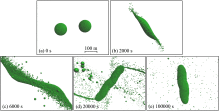Collisional elongation: Possible origin of extremely elongated shape of 1I/‘Oumuamua
Collisional elongation: Possible origin of extremely elongated shape of 1I/‘Oumuamua
KeisukeSugiura, Hiroshi Kobayashi, Shu-ichiro Inutsuka,
https://doi.org/10.1016/j.icarus.2019.03.014
Light curve observations of a recently discovered interstellar object 1I/‘Oumuamua suggest that this object has an extremely elongated shape with the axis ratio 0.3 or smaller. Planetesimal collisions can produce irregular shapes including elongated shapes. In this paper, we suggest that the extremely elongated shape of 1I/‘Oumuamua may be the result of such an impact. To find detailed impact conditions to form the extremely elongated objects, we conduct numerical simulations of planetesimal collisions using Smoothed Particle Hydrodynamicsmethod for elastic dynamics with self-gravity and interparticle friction. Impacts into strengthless target planetesimals with radius 50 m are conducted with various ratios of impactor mass to target mass q, friction angles ϕd, impact velocities vimp, and impact angles θimp. We find that impacts with q ≥ 0.5, ϕd ≥ 40°, vimp ≤ 40 cm/s, and θimp ≤ 30° produce remnants with the ratio of intermediate to major axis length <0.3. This impact condition suggests that the parent protoplanetary disk in the planetesimal collision stage was weakly turbulent (α < 10−4 for the inner disk) and composed of planetesimals smaller than ∼7 km to ensure small impact velocity.

